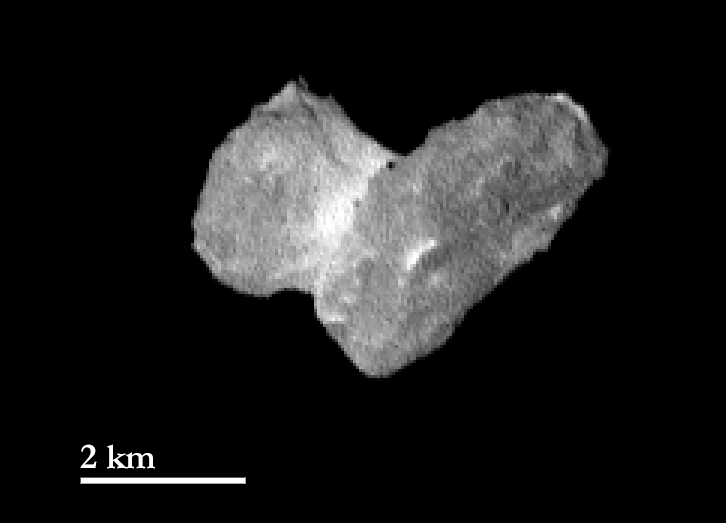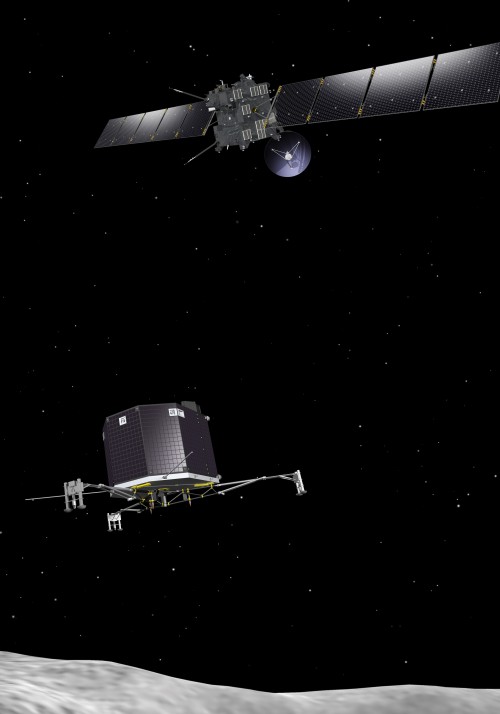
Carl Sagan has been credited with the quote, “Somewhere, something incredible is waiting to be known.” One of the Solar System’s intrepid voyagers is nearly at the end of its decade-long quest, and it has already uncovered some incredible things about its intended target.
In a matter of days, the European Space Agency’s (ESA) Rosetta spacecraft will approach comet 67P/Churyumov–Gerasimenko. Having made a series of burns throughout July, according to the ESA, Rosetta will make two short orbital insertion burns today and Wednesday, Aug. 6, when the spacecraft is expected to approach the comet at a distance of approximately 100 kilometers (62 miles). In addition, imaging and temperature data have unlocked some of the comet’s secrets.
On Friday, Aug. 1, it was announced that Rosetta’s first temperature measures of 67P/Churyumov–Gerasimenko revealed that it wasn’t covered in ice as previously expected. The discovery was made by the spacecraft’s visible, infrared, and thermal imaging spectrometer (VIRTIS). This instrument’s sensor monitored infrared light from the comet at distances between 14,000 kilometers (approximately 8,700 miles) and 5,000 kilometers (3,100 miles) from July 13-21. Based on data collected during this period, it was estimated that the comet’s temperature is -70 degrees Celsius.

This reading is 20 to 30 degrees warmer than what was expected. In addition, a new image obtained by the spacecraft revealed that instead of having what scientists refer to as a “clean icy surface,” the surface of the comet appears to be dusty and rugged. In mid-July, it was also revealed that the comet has what was described by ESA’s Rosetta blog as an “extraordinarily irregular shape,” also unexpected.
In upcoming months, more data collected through imaging and VIRTIS will better determine the composition of the comet’s surface, which is instrumental in determining a landing site for Philae, Rosetta’s lander. Philae is scheduled to touch down on 67P/Churyumov–Gerasimenko in November this year, marking the first cometary landing in spaceflight history. The ESA announced: “In addition to global measurements, the sensor will study the variation of the daily surface temperature of specific areas of the comet, in order to understand how quickly the surface reacts to solar illumination. In turn, this will provide insight into the thermal conductivity, density and porosity of the top tens of centimeters of the surface.”
As the comet flies closer to the Sun during the next year, scientists and researchers are enthusiastic to see what will happen as things start to “heat up.” Matt Taylor, ESA’s Rosetta project scientist, summed up his team’s excitement over the comet’s evolving nature.
“Combined with observations from the other 10 science experiments on Rosetta and those on the lander, VIRTIS will provide a thorough description of the surface physical properties and the gases in the comet’s coma, watching as conditions change on a daily basis and as the comet loops around the Sun over the course of the next year. With only a few days until we arrive at just 100 km distance from the comet, we are excited to start analyzing this fascinating little world in more and more detail,” he related.
Rosetta, which launched in March 2004 from Europe’s Spaceport in Kourou, French Guiana, aboard an Ariane 5 launch vehicle, has already defied the odds this year. In January, the spacecraft famously “woke up” after a 31-month-long hibernation period. In March, Philae was also successfully reactivated. The spacecraft has been described as being robust and healthy despite its long sleep period and an arduous voyage of 6.4 billion kilometers (4 billion miles) through the Solar System.
While Rosetta’s decade-long marathon may be coming to its conclusion, the journey is far from over, as the spacecraft (along with its lander) will continue to reveal comet 67P/Churyumov–Gerasimenko’s unique character through the end of its science mission, intended to last until December 2015.
This video from ESA’s YouTube channel details Rosetta’s mission and the history of comets.
Stay tuned to AmericaSpace for further updates about ESA’s Rosetta mission.
Want to keep up-to-date with all things space? Be sure to “Like” AmericaSpace on Facebook and follow us on Twitter: @AmericaSpace
Missions » Rosetta »



